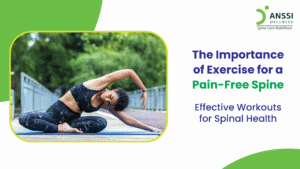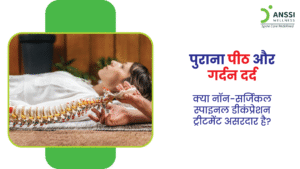It’s not as hard as you might think. Let’s understand what do these terms imply.
All 3 mentioned conditions begin with the prefix “spondy.” It refers to the spinal column or vertebrae. Something is wrong with your spine if any of these conditions are observed. However, these conditions can be treated conservatively, so don’t worry!
First, let’s examine the difference between the three “spondy” conditions.
Spondylosis
This condition includes a stress fracture defect in the pars interarticularis of the vertebrae, which is a region typically located in the L4/L5 region of the vertebral column. It is typically caused by strenuous activities that require excessive twisting, rotation, or back bending (for example – football, dancing, gymnastics, and wrestling.) Such activities often result in repetitive stress or trauma to the lumbar spine. Initial symptoms may or may not be present; however, as the injury progresses, the affected person may complain of pain when bending backwards or when performing general activities.
Spondylolisthesis
It usually means how a spondylosis injury progresses, but can also refer to something that happens at birth or is idiopathic (with unknown cause.) There will be a displacement of one vertebra over the vertebral body below it at the L5/S1 level, also known as a “step off” or “slip”. People may even be able to see a bump in the area where the slippage is occurring. The degree to which the vertebral body has slipped defines each of the five grades of this slippage:
- Grade 1: O-25%
- Grade 2: 25 to 50%
- Grade 3: 50-75%
- Grade 4: 75-100%
- Grade 5: > 100%
People with this condition may experience intermittent, localised pain when bending forward or backwards at the affected area. As the vertebrae slide, it causes compression of the nerve root below, resulting in radicular pain down one or both legs, tense hamstrings, rare loss of bowel/bladder, and difficulty with walking or standing.
Spondylitis
Spondylitis is an inflammatory condition that affects the spine, causing pain, stiffness, and reduced flexibility. It can lead to spinal fusion, impacting mobility. Its types include ankylosing spondylitis, cervical spondylitis, and more. Symptoms range from chronic back pain to joint swelling. Early diagnosis and treatments like spinal decompression can help manage symptoms effectively.
Treatment for “Spondy”
Your doctor will look at your posture, range of motion, and overall health during a physical examination. They will also test your reflexes and feel your spine for muscle spasms and abnormal curves. Most of the time, people take conservative measures to treat their condition. Medication for pain and inflammation may be beneficial. Additionally, you can always consult a physical therapist to assist with pain reduction and mobility improvement. Stabilising the area with a brace may also be helpful.
Steroid injections into the epidural space can also provide some relief. Here, a combination of steroids and painkillers is injected into the affected area by your doctor to reduce discomfort and inflammation.
Surgery may be your last option if you are in severe pain or have not responded to conservative treatments. Given the risks involved in surgical operations, non-surgical alternatives are often preferred.
Non-Surgical Spinal Decompression
Non-surgical spinal decompression can help alleviate pressure on the affected area and stabilise the spinal region. In this procedure, all a patient has to do is lie down on a special table. A machine will be connected to the patient that gently stretches the spine and relieves pressure on the discs, joints, and connective tissues. The machine controls the level of tension, which is set to a predetermined level, based on the patient’s condition.
The spinal decompression is applied in multiple sessions to enable healing of the spine and provide long-lasting relief.
About ANSSI:
ANSSI Wellness focuses on improving the quality of life for patients suffering from spinal issues, aiming to provide relief where other conventional treatments have failed. Through advanced non-surgical spinal decompression treatment, ANSSI is committed to helping patients avoid surgery and recover in a safe, effective, and compassionate environment.
FAQs
Yes, in many cases, the bulging disc symptoms go away after a period of time.
MRI is the best diagnostic test to detect herniated and bulging discs.
Massage can provide short-term relief from chronic back pain caused by a bulging disc.



